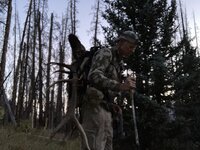wapitiwilly
FNG
I have been hunting deer for a long time am very comfortable getting a deer out by myself, but this will be my first-year hunting elk and I am planning on going out for the archery season this September.
I typically hunt by myself and like to get far away from people but if I get something I want to make sure I can get everything out by myself.
I'm curious how much time I have until the meat spoils? I plan on quartering it out as soon as possible and hanging the meat in the shade or near a creek if I can while I make trips back and forth to the truck.
Any other advice for keeping meat good in September is greatly appreciated.
Thanks
I typically hunt by myself and like to get far away from people but if I get something I want to make sure I can get everything out by myself.
I'm curious how much time I have until the meat spoils? I plan on quartering it out as soon as possible and hanging the meat in the shade or near a creek if I can while I make trips back and forth to the truck.
Any other advice for keeping meat good in September is greatly appreciated.
Thanks
Last edited:

